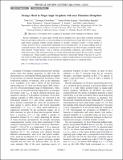| dc.contributor.author | Cao, Yuan | |
| dc.contributor.author | Chowdhury, Debanjan | |
| dc.contributor.author | Rodan-Legrain, Daniel | |
| dc.contributor.author | Rubies-Bigorda, Oriol | |
| dc.contributor.author | Watanabe, Kenji | |
| dc.contributor.author | Taniguchi, Takashi | |
| dc.contributor.author | Todadri, Senthil | |
| dc.contributor.author | Jarillo-Herrero, Pablo | |
| dc.date.accessioned | 2020-05-06T14:06:31Z | |
| dc.date.available | 2020-05-06T14:06:31Z | |
| dc.date.issued | 2020-02-18 | |
| dc.date.submitted | 2019-11 | |
| dc.identifier.issn | 1079-7114 | |
| dc.identifier.issn | 0031-9007 | |
| dc.identifier.uri | https://hdl.handle.net/1721.1/125039 | |
| dc.description.abstract | Recent experiments on magic-angle twisted bilayer graphene have discovered correlated insulating behavior and superconductivity at a fractional filling of an isolated narrow band. Here we show that magic-angle bilayer graphene exhibits another hallmark of strongly correlated systems—a broad regime of T-linear resistivity above a small density-dependent crossover temperature—for a range of fillings near the correlated insulator. This behavior is reminiscent of similar behavior in other strongly correlated systems, often denoted “strange metals,” such as cuprates, iron pnictides, ruthenates, and cobaltates, where the observations are at odds with expectations in a weakly interacting Fermi liquid. We also extract a transport “scattering rate,” which satisfies a near Planckian form that is universally related to the ratio of (k[subscript B]T/ℏ). Our results establish magic-angle bilayer graphene as a highly tunable platform to investigate strange metal behavior, which could shed light on this mysterious ubiquitous phase of correlated matter. ©2020 | en_US |
| dc.description.sponsorship | National Science Foundation (grant no. DMR-1809802) | en_US |
| dc.description.sponsorship | NSF (grant no. DMR-1231319) | en_US |
| dc.description.sponsorship | NSF (grant no. GBMF4541) | en_US |
| dc.description.sponsorship | U.S. Department of Energy (award no. DE-SC0008739) | en_US |
| dc.publisher | American Physical Society | en_US |
| dc.relation.isversionof | 10.1103/PhysRevLett.124.076801 | en_US |
| dc.rights | Article is made available in accordance with the publisher's policy and may be subject to US copyright law. Please refer to the publisher's site for terms of use. | en_US |
| dc.source | American Physical Society | en_US |
| dc.title | Strange metal in magic-angle graphene with near Planckian dissipation | en_US |
| dc.type | Article | en_US |
| dc.identifier.citation | Cao, Yuan, et al., "Strange metal in magic-angle graphene with near Planckian dissipation." Physical Review Letters 124 (2020): no. 076801 doi 10.1103/PhysRevLett.124.076801 ©2020 Author(s) | en_US |
| dc.contributor.department | Massachusetts Institute of Technology. Department of Physics | en_US |
| dc.relation.journal | Physical Review Letters | en_US |
| dc.eprint.version | Final published version | en_US |
| dc.type.uri | http://purl.org/eprint/type/JournalArticle | en_US |
| eprint.status | http://purl.org/eprint/status/PeerReviewed | en_US |
| dc.date.updated | 2020-02-18T15:58:28Z | |
| dc.language.rfc3066 | en | |
| dc.rights.holder | American Physical Society | |
| dspace.date.submission | 2020-02-18T15:58:28Z | |
| mit.journal.volume | 124 | en_US |
| mit.license | PUBLISHER_POLICY | |
| mit.metadata.status | Complete | |
